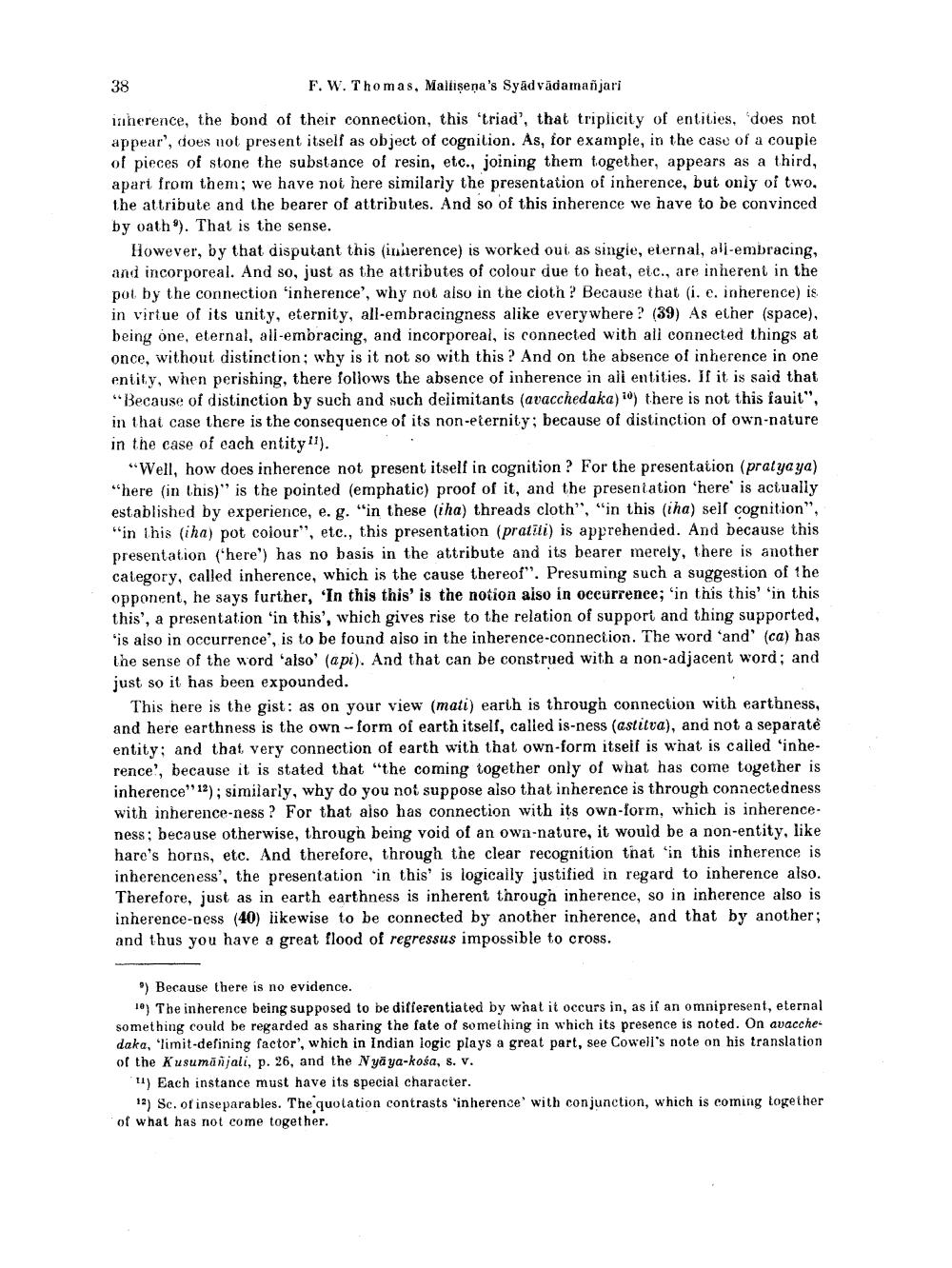________________
38
F. W. Thomas, Mallisena's Syadvādamañjari
inherence, the bond of their connection, this 'triad', that triplicity of entities, does not appear', does not present itself as object of cognition. As, for example, in the case of a couple of pieces of stone the substance of resin, etc., joining them together, appears as a third, apart from them; we have not here similarly the presentation of inherence, but only of two, the attribute and the bearer of attributes. And so of this inherence we have to be convinced by oath"). That is the sense.
However, by that disputant this inherence) is worked oui as single, eternal, ali-embracing, and incorporeal. And so, just as the attributes of colour due to heat, etc., are inherent in the pot by the connection inherence', why not also in the cioth? Because that (i. e, inherence) is in virtue of its unity, eternity, all-embracingness alike everywhere? (39) As ether (space), being one, eternal, ali-embracing, and incorporeal, is connected with all connected things at once, without distinction; why is it not so with this? And on the absence of inherence in one entity, when perishing, there follows the absence of inherence in all entities. If it is said that "Because of distinction by such and such delimitants (avacchedaka)10) there is not this fauit", in that case there is the consequence of its non-eternity: because of distinction of own-nature in the case of each entityil).
"Well, how does inherence not present itself in cognition ? For the presentation (pratyaya) "here in this)" is the pointed (emphatic) proof of it, and the presentation where is actually established by experience, e. g. "in these (iha) threads cloth", "in this (iha) self cognition", "in this (iha) pot colour", etc., this presentation (pratili) is apprehended. And because this presentation (here') has no basis in the attribute and its bearer merely, there is another category, called inherence, which is the cause thereof". Presuming such a suggestion of the opponent, he says further, 'In this this is the notion also in occurrence; 'in this this' 'in this this', a presentation in this', which gives rise to the relation of support and thing supported, 'is also in occurrence', is to be found also in the inherence-connection. The word 'and' (ca) has the sense of the word 'also' (api). And that can be construed with a non-adjacent word; and just so it has been expounded.
This here is the gist: as on your view (mati) earth is through connection with earthness, and here earthness is the own- form of earth itself, called is-ness (astitva), and not a separate entity; and that very connection of earth with that own-form itself is what is called 'inherence', because it is stated that "the coming together only of what has come together is inherence" 12); similarly, why do you not suppose also that inherence is through connectedness with inherence-ness? For that also has connection with its own-form, which is inherence. ness, because otherwise, through being void of an own-nature, it would be a non-entity, like hare's horas, etc. And therefore, through the clear recognition that 'in this inherence is inherenceness', the presentation in this is logically justified in regard to inherence also. Therefore, just as in earth earthness is inherent through inherence, so in inherence also is inherence-ness (40) likewise to be connected by another inherence, and that by another; and thus you have a great flood of regressus impossible to cross.
) Because there is no evidence. 1) The inherence being supposed to be differentiated by what it occurs in, as if an omnipresent, eternal something could be regarded as sharing the fate of something in which its presence is noted. On avacchedaka, limit-defining factor, which in Indian logic plays a great part, see Cowell's note on his translation of the Kusumanjali, p. 26, and the Nya ya-kosa, s. v. ') Each instance must have its special character.
12) Sc. of inseparables. The quotation contrasts 'inherence with conjunction, which is coming together of what has not come together.




